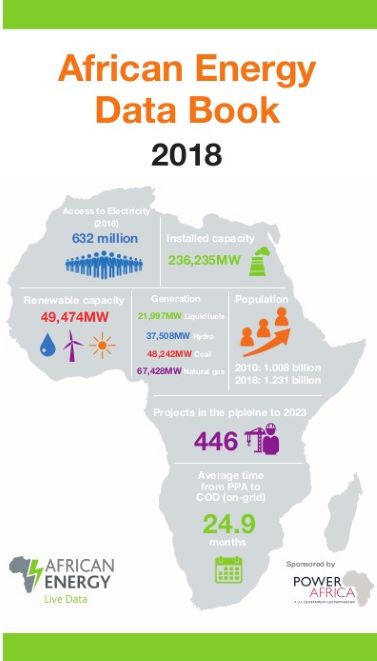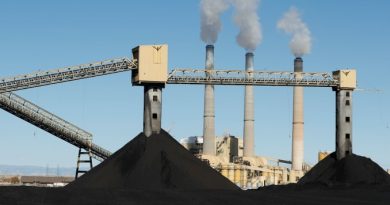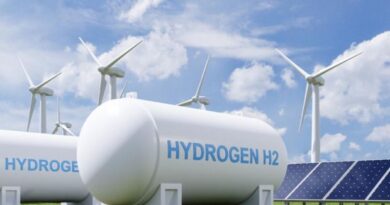Africa Updates. Consultancy Launches Africa’s First Energy Data Book

The African Energy Data Book was launched in London by the UK-Based consultancy Africa Energy at the fifth annual African Investment Exchange: Power and Renewables meeting, which took place on November 14 and 15. The Meeting brought together investors from across all African electricity sectors. The Data Book has been designed to support industry professionals with 128 pages of comprehensive statistics on the energy mix in each of the continent’s countries and regions. The book complements the established African Energy Atlas to ensure that up-to-date and reliable information is available.
The publication tracks around 5,500 operating and pipeline projects and their value up to 2021, through African Energy Live Data, said the press conference presenters.
The African Energy Data Book though does not provide any analysis or trends yet but does indicates that installed capacity has increased by more than 63% to 236GW since 2010. It says that the continent has over 49 GW of renewable capacity. According to the African Energy atlas, a total of 15.5GW installed capacity was added in Africa in 2017.In sub-Saharan Africa, capacity at end-2018 is expected to be nearly 50% greater than in 2010.
These both books are available for sale at its website.
To read the sample click here.
Other Key highlights
- Natural gas and dual-fuel plants have seen significant growth. In 2010 these plants accounted for 40% of generation capacity, but by end-2018 this will likely increase to nearly 48%.
- This trend is not restricted to North Africa, where the bulk of gas and dual-fuel plants are located. In Sub Saharan Africa or SSA, gas and dual-fuel plants are expected to account for 19% of capacity by end-2018, up from around 14% in 2010.
- By end-2018 coal-fired installed capacity is expected to grow by 13% since 2010 – and is not expected to peak in capacity terms until 2022, at about 60GW. But coal-fired capacity has fallen from around 29% in 2010 to 20% of the generation mix in 2018 ; in SSA, coal’s role has diminished even further, from 47% to 35%.
- Despite large-scale commitments of finance and investment to solar, wind and other projects, the proportion of renewable energy in the generation mix has actually declined so far in 2018 in all but one region.
- Installed solar – mostly photovoltaic (PV) – capacity has increased more than 45 times since 2010 and is expected to double again in just two years, reaching as much as 8,711MW by end-2020, from 4GW in 2018. However, by end-2018 it will still only account for 1.8% of Africa’s total generation capacity.
- Wind capacity is set to nearly double by 2021, increasing from 5.7GW to more than 10GW. It will already be more than five times larger by end-2018 than it was in 2010, but the technology will still represent only 2.4% of installed capacity.
- Despite promising trends in a few key markets, geothermal and biomass barely register at an aggregate level. However, geothermal development is expanding rapidly: projects progressing in Kenya and Ethiopia mean that geothermal capacity should double by 2020 and could treble by 2023.
- There has been a spike in the development of liquid fuels (diesel, HFO, and other fuel oils) in North Africa, where plants powered entirely using liquid fuels have increased by 72% since 2010 – despite the region’s abundance of natural gas and renewable resources.
- In SSA, plants powered entirely by liquid fuel account for 12.4% of capacity in 2018 compared with 10.3% in 2010. (The data do not include the huge number of smaller diesel-fired gensets that still dominate generation in Nigeria and other countries in SSA.)
- Despite this longer-term trend, in the eight months to 1 September, the proportion of liquid fuels in the generation mix has fallen slightly in all regions other than Southern Africa.
- The total capacity of projects signing power purchase agreements in Africa has increased from less than 1GW/yr in 2010 and 2011 to 5-6GW/yr in 2016-17.
AfDB Unveils Africa Energy Portal
In other developments on similar lines, the Africa Development Bank (AfDB) launched an Africa Energy Portal (AEP) in Johannesberg, South Africa. In a statement the AfDB said that, “The AEP portal, hosted at http://africa-energy-portal.org, will consolidate, validate, and disseminate energy data and insights across Africa’s energy value chain, covering generation, transmission, distribution, regulation and policy.”
 AfDB claims that the AEP is designed to address a lack of information in the sector, by providing a one-stop-shop for accurate, reliable, relevant, and up-to-date information on energy in Africa. This will include statistics on investment flows and deals, as well as the socio-economic outcomes of power projects.
AfDB claims that the AEP is designed to address a lack of information in the sector, by providing a one-stop-shop for accurate, reliable, relevant, and up-to-date information on energy in Africa. This will include statistics on investment flows and deals, as well as the socio-economic outcomes of power projects.
Till date there hasn’t been many attempts made to understand the complex energy needs and generation capacities of African nations. Global media reads data emanating from the continent in silos which is often incomprehensible. These developments, we think, will give us a much better understanding of the evolving nature of the continents as well as the continent in terms of its walk away from fossil fuels and towards renewable sources of energy.




